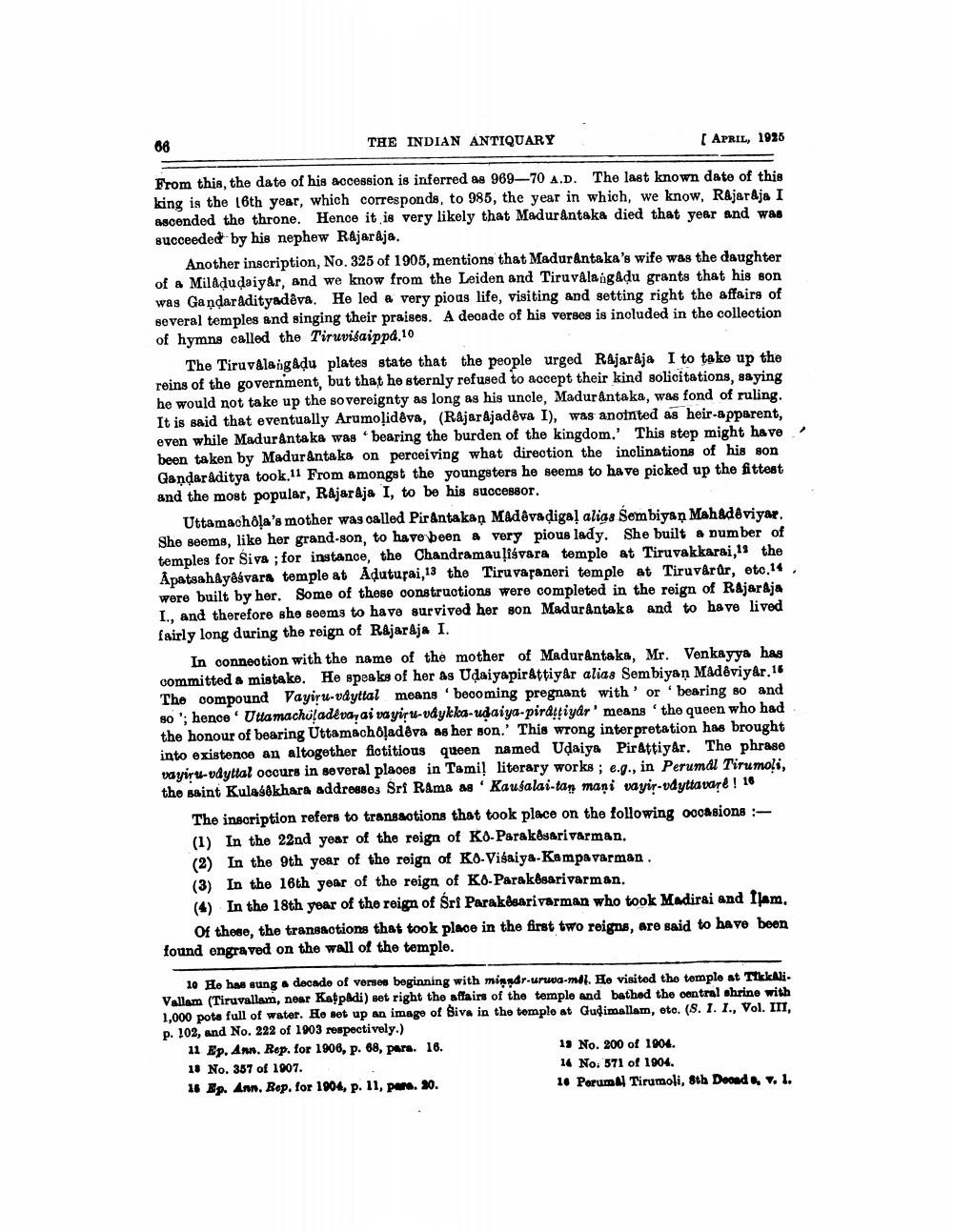________________
THE INDIAN ANTIQUARY
(APRIL, 1925
From this, the date of his accession is inferred as 969–70 A.D. The last known date of this king is the 16th year, which corresponds, to 985, the year in which, we know, Rajaraja I ascended the throne. Hence it is very likely that Madurantaka died that year and was succeeded by his nephew Rajaraja.
Another inscription, No. 325 of 1905, mentions that Madurantaka's wife was the daughter of a Miladudaiyar, and we know from the Leiden and Tiruvalangadu grants that his son was Gandaradityadeva. He led a very pious life, visiting and setting right the affairs of several temples and singing their praises. A decade of his verses is inoluded in the collection of hymns called the Tiruvisaippa.10
The Tiruvalangadu plates state that the people urged Rajaraja I to take up the reins of the government, but that he sternly refused to accept their kind solicitations, saying he would not take up the sovereignty as long as his uncle, Madurantaka, was fond of ruling. It is said that eventually Arumolidêva, (Rajarajadêva I), was anotnted as heir-apparent, even while Madurantaka was bearing the burden of the kingdom.' This step might have been taken by Madur Antaka on perceiving what direction the inclinations of his son Gandaraditya took.11 From amongst the youngsters he seems to have picked up the fittest and the most popular, Rajaraja I, to be his successor.
Uttamachôļa's mother was called Pirántakan Madêvadiga! alias Sembiyan Mahadeviyar. She seems like her grand-son, to have been & very pious lady. She built a number of temples for Siva ; for instance, the Chandramaulisvara temple at Tiruvakkarai,13 the Åpatsahâyêśvara temple at Adutupai,13 the Tiruvasaneri temple at Tiruvarur, etc.14, were built by her. Some of these constructions were completed in the reign of Rajaraja L. and therefore she seems to have survived her son Madurantaka and to have lived fairly long during the reign of Rajaraja I.
In connection with the name of the mother of Madurântaka, Mr. Venkayya has committed a mistake. He speaks of her as Udaiyapiráttiyar alias Sembiyan Madêviy Ar.16 The compound Vayiru-vdyttal means becoming pregnant with or bearing so and so '; hence Uttamachuladérayai vayiru-vdykka-udaiya-pirättiyar' means the queen who had the honour of bearing Uttamachóļadēva as her son.' This wrong interpretation has brought into existence an altogether fictitious queen named Udaiya PirAttiyar. The phrase vayiru-vdyttal occurs in several places in Tamil literary works; e.g., in Perumal Tirumoli, the saint Kulas@khara addresses Sri Rama as Kaušalai-tan mani vayir-vdyttavaré ! 16
The inscription refers to transactions that took place on the following occasions :(1) In the 22nd year of the reign of Ko-Parakesarivarman. (2) In the 9th year of the reign of Ko-Visaiya-Kampavarman. (3) In the 16th year of the reign of K0.Parakesarivarman (4) In the 18th year of the reign of Sri Parakesarivarman who took Madirai and flam.
Of these, the transactions that took place in the first two reigns, are said to have been found engraved on the wall of the temple.
10 He has sung a decade of verses beginning with mingdr-urwa-mil. Ho visited the temple at Tikkali. Vallam (Tiruvallam, near Kappadi) set right the affairs of the temple and bathed the central shrine with 1,000 pots full of water. Ho set up an image of Sivas in the temple at Gudimallam, etc. (S. I. I., Vol. III, p. 102, and No. 222 of 1903 respectively.) 11 Ep. Ann. Rep. for 1906, p. 68, para. 16.
13 No. 200 of 1904. 11 No. 357 of 1907.
14 No. 571 of 1904. 16 Ep. Ann. Rep. for 1904, p. 11, pero. 20.
10 Perum) Tirumoli, 8th Deoad, v. 1.




